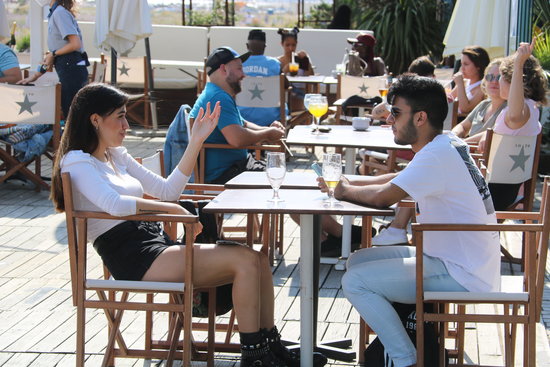Catalonia advances cautiously in lockdown easing plan
Relatively little street activity as terraces return in Barcelona and exercise time slots removed in Tarragona

Several health regions in Catalonia advanced to Phase 1 or Phase 2 in lockdown easing plan on Monday, but cautiously, with several firms allowed to open, not doing so because they believe it is not worth it taking into account the mobility restrictions and the capacity limitations.
Barcelona and metropolitan area, Phase 1
Barcelona and its metropolitan area began Phase 1 of the lockdown de-escalation process on Monday, a phase that will last at least two weeks.
One of the biggest differences between this phase and the previous Phase 0 is the reopening of bar and restaurant terraces, an integral part of the culture of the Catalan capital.
Exercise time slots are still in place, but people can visit any open business outside of these hours, meaning more life slowly and cautiously came back to the streets of Barcelona with the return of terraces.
However, as with every phase of the de-escalation plan, there are safety limits in place, and in Barcelona terraces can only operate at 50% capacity.
The city's bar and restaurant association has said that this level of business is not viable for many terraces to reopen, and as such only around one-third of bars with outdoor seating welcomed customers back today. Most bars in the city will instead wait until Phase 2 before reopening.
Beach bars, or 'xiringuitos' as they are known in Catalan, were also given the green light to serve once more. However, like bars around the city, most remained closed on the first day, but on Monday were preparing to open for the rest of the week.
More welcome news for beach bars came today from the Barcelona city council, who announced that people will be able to use the city's beaches for strolls and exercise in the evening time slots (8-11pm) from today, and not just in the 6-10am morning slot.
The aim of the local council with this decision is to spread out the number of people visiting the beaches, as up until now, most people have only been allowed to visit between 6-10am, meaning huge crowds have visited during this short window of opportunity. Children and an accompanying adult are able to go for walks on the beach from midday to 7pm, with 10am to midday and 7-8pm reserved for the elderly and vulnerable.
Overall the streets of the Catalan capital's 'Ciutat Vella,' or 'Old Town,' were still relatively quiet, despite the new freedoms granted to people and businesses. Even though many bars could open, most didn't, and even though people can wander the streets for the purpose of going to a shop, the amount of people on the streets was not particularly high.
Despite this, friends and family are once again allowed to see each other and be in each other's company. Socializing in groups of up to ten healthy people without underlying conditions is again allowed, both in outdoor settings as well as in people's homes.
With Barcelona city being a health region on its own, and with traveling between different health regions prohibited at this stage of the de-escalation plan, effectively Barcelona is cut off from the rest of the country, with nobody allowed to enter or leave, except for work or health reasons.
The Catalan government has proposed that the city and the north and south metropolitan regions merge from June 1, with Spain expected to make a decision this Friday.
Tarragona, Ebre and Pyrenees, Phase 2
Meanwhile, Tarragona is one of the three Catalan health regions, along with Terres de l’Ebre and the Western Catalan Pyrenees, that has entered lockdown de-escalation Phase 2 this Monday.
Like in Barcelona, and as has been the case in the southern Catalan health region for the past two weeks, café and restaurant terraces in Tarragona are open. The main difference now that the health region is in Phase 2 is that diners can enjoy their meals inside too if they so wish, as long as the establishment caps its indoor capacity at 40%. But even though this is now an option, many were empty and only had a few groups of people scattered about their outdoor seating areas.
Cinemas and restaurants are allowed to reopen too, although a quick downtown stroll makes it clear that, for the most part, these cultural activities have not yet resumed. In fact, many have decided not to open because only being able to do so at a third of their usual capacity makes it unprofitable.
Other Phase 2 changes that Tarragona residents will be able to enjoy include meeting in larger groups - from 10 just a week ago, like in Barcelona, to 15 now - or the fact that exercise time slots now only apply to at-risk people. Travel, however, is still restricted to movement within the same health region only, as was the case during Phase 1.
Commercial activity, while still quite far from normal levels, is starting to pick up its pace again. Shops over 400 sqm can now open in their entirety, but they must implement new health and safety measures in an attempt to halt the spread of Covid-19.
A line of people could be seen outside Tarragona's Corte Inglés shopping center on Monday morning, for example, as they awaited their turn to enter. Shoppers are counted carefully by security - each floor can only be at 40% capacity - and must wear face masks and wash their hands with hand sanitizer before they are allowed inside. Aside from this, clothing is disinfected if tried on but not bought, makeup testers are off limits, and stickers on the floor indicate a 2-meter safety distance if crowds were to form.